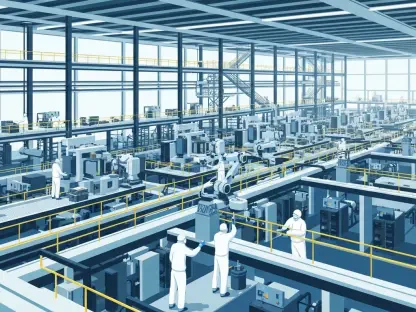The global Data Center Mechanical Construction market is on a trajectory of steady and substantial growth, projected to expand to $42.7 billion by 2030 from an estimated $17.8 billion in 2023. This expansion is significantly driven by the escalating demand for scalable mechanical construction solutions, particularly within hyperscale data centers. A recently released report from Dublin on November 13, 2024, provides a comprehensive analysis of market trends, drivers, forecasts, and key challenges. It’s designed to support informed business decisions for stakeholders, industry professionals, and investors.
Rising Demand for Data Storage and Processing
One of the central factors contributing to the market’s growth is the exponential increase in data generation across various sectors. This increase necessitates extensive data storage and processing facilities. The proliferation of cloud computing and the expansion of internet services have led to a significant rise in the demand for new data centers. Consequently, this development propels the need for advanced mechanical systems to equip these infrastructures.
Moreover, regulatory pressures and a growing emphasis on sustainability are compelling data centers to adopt more energy-efficient mechanical solutions. This sector’s growth is also bolstered by the rise of edge computing, which requires the establishment of smaller, decentralized data centers. These facilities demand specialized mechanical construction services tailored to accommodate new infrastructure models, further fueling market expansion.
Technological Advancements in Mechanical Systems
Technological advancements play a pivotal role in shaping the data center mechanical construction sector. The industry’s ongoing efforts to reduce the environmental footprint of data centers lead to the adoption of innovative cooling solutions. Liquid cooling and free-air cooling are highlighted as more efficient alternatives to traditional air conditioning. Additionally, the integration of AI and IoT technologies in data center management systems enables real-time monitoring and optimization of mechanical systems, enhancing energy efficiency and reducing operational costs.
The trend towards modular data center designs, which allow for scalable and more flexible construction, is integral to the evolving practices within mechanical construction. These advancements not only improve efficiency but also support the growing demand for data center infrastructure. Modular designs offer adaptable solutions that cater to both current and future requirements, facilitating smoother expansions and upgrades.
Challenges in Balancing Performance and Energy Efficiency
Despite these advancements, the industry faces significant challenges. One of the primary hurdles is achieving a balance between performance and energy efficiency. As data centers expand capacity to meet growing data processing and storage demands, they must avoid a corresponding increase in energy consumption. This balancing act necessitates careful planning and design of mechanical systems to optimize performance while minimizing energy use.
Integrating new technologies into existing data center infrastructures poses another challenge, often entailing complexity and high costs. Ensuring the reliability of mechanical systems under extreme conditions, such as natural disasters or power outages, remains a critical concern for data center operators. This reliability is crucial to maintaining uninterrupted operations and safeguarding data integrity. Strategies to mitigate these risks and achieve robust performance must be an integral part of mechanical construction plans.
Market Segments and Regional Trends
The report provides significant insights into market segments and regional trends. Particularly notable is the Cooling Solutions segment, which is projected to experience substantial growth, reaching $29.7 billion by 2030 with a CAGR of 13.9%. The Racks segment is also set to grow at a CAGR of 12.9% over the analysis period. On a regional scale, the U.S. market, estimated at $4.8 billion in 2023, is highlighted alongside China, which has an impressive forecasted growth at an 18.0% CAGR, potentially reaching $9.5 billion by 2030.
Additional regional insights cover key areas like Japan, Canada, Germany, and the broader Asia-Pacific region. Understanding these diverse market dynamics and regional opportunities is crucial for stakeholders keen on leveraging growth prospects within different geographic markets. These insights are essential for tailoring strategies and investments to specific market conditions and consumer needs across regions.
Emerging Trends and Drivers Shaping the Market
The global Data Center Mechanical Construction market is experiencing significant and steady growth, with projections indicating it will reach $42.7 billion by 2030, up from an estimated $17.8 billion in 2023. This growth is largely fueled by the rising demand for scalable mechanical construction solutions, especially within hyperscale data centers. According to a newly published report from Dublin on November 13, 2024, the market’s trends, drivers, forecasts, and key challenges have been thoroughly analyzed. The report aims to aid stakeholders, industry professionals, and investors in making well-informed business decisions. This comprehensive study reveals the increasing emphasis on sophisticated infrastructure and advanced technologies, underscoring the necessity for efficient cooling systems, power management, and sustainable practices within data centers. As the digital landscape continues to evolve, the necessity for enhanced mechanical construction solutions in data centers becomes all the more critical, ensuring they meet the growing demands of data storage, processing, and security.









